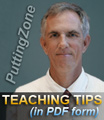please wait...
Item Popularity: 0/5
(0 votes cast)
Total Views: 2765
For consistent and accurate distance and line control, start with a single slow tempo or timing from start to finish for all putts regardless of length of about two full seconds, a nice easy "one potato, two potato" stroke -- your brain relies upon it!
 From: PuttingZone - Teaching Tips (PDFs)
From: PuttingZone - Teaching Tips (PDFs)
Geoff Mangum of the PuttingZone has created a large assortment of helpful PDFs with detailed tips for improving and mastering your putting.
optputtebook.php
Please Login or Sign-up for FREE to view this video.


Comments
Please log in to leave a comment.